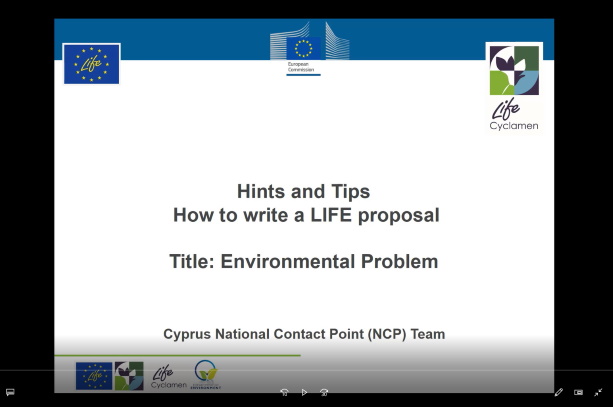
The original transcript can be found below:
This is a video on How to write a LIFE proposal. Part of a series of videos aiming at helping you to write a well written proposal under the LIFE Programme.
In this video we will talk about how you should define the Environmental Problem.
When writing about the environmental problem you must use data to justify the existence of the problem. That data could be from reports of Official organisations or Public bodies, surveys from the Statistical Service, EUROSTAT, Eurobarometer, research papers etc.
Remember, the general objective of LIFE is to contribute to the implementation, updating and development of EU environmental and climate policy and legislation.
You therefore need to explain why you consider that this problem is related to a European Environmental or climate policy or legislation and you should specify how your project will help with the implementation, updating or development of a specific EU environmental or climate policy and legislation.
Make sure you show that there is a clear logical link between threats/problems and the objectives, actions proposed, as well as the expected results.
This slide illustrates the thinking process when defining the environmental problem!
Now let’s see some examples on how you should define an environmental problem.
Example 1:
Our first example comes from the German project LIFE Waste2Protein (Under the Thematic Priority of the Environment and Resource efficiency).
The worlds demand for animal protein is on the rise, as is population, therefore food needs are increasing. An expected 75% rise in demand by 2050 compared to 2007 (data from World Population Prospects: The 2017 Revision) will negatively impact the environment through deforestation for soy production and overfishing for aquaculture feeding.
This growth will also result in greater greenhouse gas emissions, loss of biodiversity, an increase in antibiotic resistant genes through widespread use of antibiotics in aquaculture, and higher levels of organic waste. Only 25% of biowaste is currently recycled into high quality compost and digestate (European Compost Network), with the majority going to landfill or being incinerated.
The idea comes from the fact that insect protein meal is a resource-efficient, sustainable and environmentally-friendly alternative for animal feedstuff that can replace fish and soy meal.
The overall aim of LIFE Waste2Protein is to foster the use of biowaste as a resource to produce insect proteins from Black soldier flies (we will refer to this as BSF). The project will install a modular pilot plant to breed 300 tonnes of BSF larvae in different development stages. This will need an input of 20 tonnes of biowaste per day to feed the BSF larvae, delivered from local supermarket chains.
The project contributes to the implementation of waste legislation including the Waste Framework Directive, the Circular Economy Package and the Landfill Directive. Furthermore, it contributes to the Common Fisheries Policy, the EU action plan against antimicrobial resistance, and the 2050 low-carbon economy roadmap.
Example 2:
Our second example comes from the project LIFE for Eagles habitats (Under the Thematic Priority of Nature and Biodiversity)
With more than 600 breeding pairs of lesser spotted eagle (Clanga pomarina), Bulgaria is a stronghold for the conservation of this species in the southern part of its distribution range. This sensitive forest raptor species prefers to breed in mature forests and builds its nest in large trees. Although the population size is considered to be stable, in recent decades the numbers of mature individuals have been declining in many parts of the species range (BirdLife International 2018), especially in the core of the population (Treinys et al. 2007, Bergmanis et al. 2015). The main threats for the species are related to inappropriate forestry practices, modifications of foraging habitat, leading to habitat loss and degradation, and persecution through the migration routes and wintering grounds. At national scale, the species is classified as Vulnerable in Bulgaria’s Red Data Book, and protected by the Biodiversity Law. However, the species is unevenly distributed in the country, with more than 70% of the population concentrated in southeast and east Bulgaria, and poorly represented in the western part of the country (Iankov 2007).
The overall objective of the LIFE for Eagles habitats project is to contribute to the long-term protection of the Bulgarian breeding population of the lesser spotted eagle, and to the European population crossing Bulgaria during migration, by securing the protection and sustainable management of its existing breeding and feeding habitats, and by creating new habitats. The project will support the EU Birds and Habitats Directives.
To sum up, through our examples we saw how you can define the environmental problem that your LIFE Project will be tackling. We also talked about describing the problem and justifying its existence using data like reports of Official organizations or surveys from the Statistical Service, EUROSTAT, Eurobarometer, research papers etc.
Make sure you show that there is a clear logical link between threats/problems and the objectives, actions proposed, as well as the expected results.
Last but not least always remember that you need to specify why you consider that this problem is related to a European Environmental or climate policy or legislation and how your project will help with the implementation, updating or development of a specific EU environmental or climate policy and legislation.
Thank you so much for watching. This video was prepared by the Cypriot NCP Team through the LIFE Cyclamen project. With the financial contribution of the LIFE Programme – EU’s funding instrument for the environment and climate action.
Don’t forget to like, subscribe and hit the notification bell to be instantly informed about our next videos that will be published soon. Our second video will be about defining the Objectives and Results of your Project. Stay tuned!


